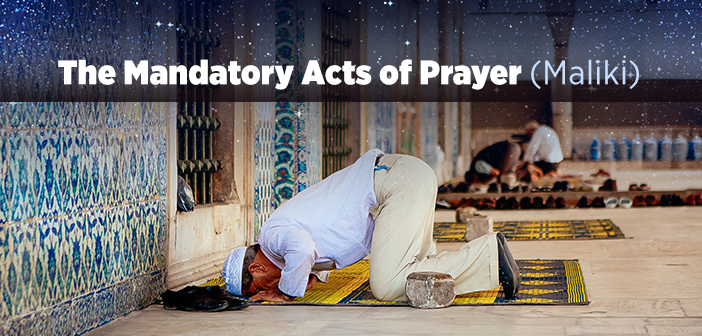What is the mandatory acts of prayer? What is the fard of salah?
The mandatory acts of prayer (arkan) are the following:
1. Niyyah (intention)
The niyyah is fard for every act of ‘ibadah. Niyyah for a prayer means knowing which prayer will be performed. The niyyah does not necessarily need to be expressed verbally and it is better not to do so.
2. Initial takbeer or Opening Takbeer (Takbeer ihram)
This is the act of beginning the prayer by praising Allah and acknowledging His Greatness with the two words “Allahu Akbar”.
3. Saying the Initial Opening Takbeer while Standing
It is fard to say the opening takbeer while standing for fard prayers. For nawafil prayers (voluntary), it is fine to say it while sitting. A person who joins the congregational prayer after the first raka’ah (masbuq) is not required to say the opening takbeer while standing.
For a person who has no strength to stand up, it is mandub for this person to pray whilst leaning on a wall or pole etc. If he prays while sitting although he may stand up by leaning on something, his prayer remains valid.
It is mandub for a person who prays while sitting to cross his legs. He should perform both the ruku’ and sajdah with his legs are crossed, and also the opening takbeer. When he prostrates however (sajdah), he should modify his leg position by bringing his feet behind him so that his toes touch the ground. Between the prostrations and while sitting for tashahhud, he should sit on his knees.
For a person who is unable to even pray whilst sitting, it is mandub for him to lie down on his right side facing the qibla and perform his prayer with indication. However if he cannot lie down on his right side, he may do so on his left. And if he cannot do this either, he may pray on his back with his feet facing the qiblah. And if he cannot do this either, he may lie on his stomach and perform the prayer with his head facing the qiblah.
If a person is able to stand however unable to bend for ruku’, prostrate or sit, he may perform the ruku’ and sajdah (with indication) while standing. He or she may not simply pray with indication while lying down. A person may perform ruku’ with indication while standing up (qiyam) and sajdah (with indication) while sitting, if he or she is only able to stand or sit and unable to bend or prostrate. If he or she does otherwise, the prayer is invalid.
If a person does not have the strength to fulfil any of the acts of prayer other than the niyyah (intention), he may carry out only what he is able to. Any person whose conscious remains with him, should not delay or miss the prayers in their proper times. This is the same for a person who is only able to pray with indication (along with niyyah).
4. Reciting the Fatiha
It is fard for an imam or a person praying independently to recite the Fatiha during every raka’ah of the prayer. However, when praying behind an imam, the imam is responsible for reciting the Fatiha, and it is not fard for his followers in the congregation.
If a person purposely does not recite Fatiha in even a single raka’ah, his prayer is invalid.
5. Standing Position (Qiyam) to Recite the Fatiha
It is fard to stand up for qiyam and read the Fatihah while in this position, whether praying alone or behind an imam. Reading the Fatiha whilst sitting invalidates the prayer. However, it is not fard for a person who is following the imam to be standing up while reading the Fatiha.
6. Ruku’
Ruku’ is the act of bowing which is done so that the palms are placed just above the knees. Tilting the head downwards is not sufficient for ruku’. The back is to be straight and hands are placed on the knees, this act (of placing the hands on knees) is mandub.
Allah says in The Qur’an; “O you who believe! Bow down and prostrate!” (Hajj 77)
Rasulullah’s beloved wife A’ishah (r.a) has said the following: “When The Messenger of Allah would bow for ruku’ he would not lift his head up, nor would he tilt it downwards. He would keep it at a position between the two.”[1] “When The Prophet would perform ruku’, if a glass of water was placed on his back, it would not spill.”[2]
7. Rising from The Ruku’
8. Sajdah (Prostration)
Sajdah is the act of putting one’s forehead on a surface, such as the ground. It is enough to place any part of the forehead for it to be a sajdah, however placing the nose on the ground along with the forehead is mandub.
The Prophet (p.b.u.h) has said: “I was commanded to prostrate with seven limbs. These are; forehead, (he pointed at his nose), both hands, both knees and both feet.” [3]
Sajdah is one of the most important parts of prayer. In Islam, prostration is done only to Allah. It is the best act of showing one’s respect, submission and servitude to Allah. The Prophet has said in a hadith: “A servant is closest to Allah while in prostration (sajdah). Make a lot of du’a during sajdah.”[4]
9. Sitting between two the two prostrations (sujood)
10. Giving Salam
Giving salam at the end of prayer is the last fard act of the prayer. This is done by saying “Assalamu ‘Alaikum”. It is not adequate to say just “salamun” or without adding “alaikum” straight after “Assalamu”. The two words must be said together without any pause. If the salam is not said in this way, the prayer will nnot be valid.
11. Being seated to give the salam
12. Tuma’ninah
This means that the limbs and body reach a stationary state and come to rest at every position.
13. I’tidal
Following ruku’ and sajdah, when giving salam, when starting the prayer with a takbeer, the praying person must have i’tidal, which means to rise and remain straight and upright; it is fard to do so.
14. Following The Prescribed Order (Tarteeb)
The praying person first makes his intention, then says the takbeer, then he recites Fatihah, he bends for ruku’, then rises again and so on. The prayer has a certain order and following this order and the order of actions between mandatory acts is fard.
[1] Müslim, Salat 240 [2] Buhari, Ezan 120 [3] Buhari, Ezan 133 [4] Müslim, Salat 215
Source: Fiqh1 (According To The Maliki School Of Islamic Law), Erkam Publications





